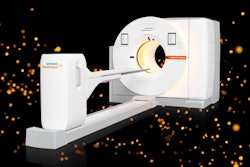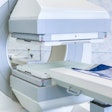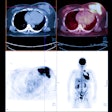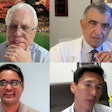A brain image database created by a multinational research team caught the attention of Dr. Henry Wagner, and was selected by the Society of Nuclear Medicine (SNM) as its image of the year at the 2004 annual meeting in Philadelphia.
The study, "Brain FDG PET Imaging in a Population-Based Cohort of Asymptomatic Subjects: Initial Findings," was led by Dr. Satoshi Minoshima, professor of radiology and bioengineering and head of the primate PET imaging suite at the University of Washington in Seattle. The research took place at the Hamamatsu Medical Imaging Center in Hamakita City, Japan; the University of Washington; and the University of Michigan in Ann Arbor, MI.
The images in the database are composites of brain scans of 31 Alzheimer’s disease (AD) patients and 551 normal patients. Because they are composites, the images reveal common functional characteristics of the disease. They form an Alzheimer’s disease database that can be compared with an individual patient’s brain scan to see if that person's brain is exhibiting similar characteristics.
"I selected the image because it best represented the theme of this year's meeting, which is creating lifetime images of health and disease," Wagner said.
The thousands of images presented at the SNM meetings and in the nuclear medicine literature should become the foundation for an international health database, Wagner suggested. Subsequently, such a database would incorporate other health manifestation data.
A total of 7,133 physicians, scientists, pharmacists, technologists, and exhibitors attended this year’s SNM conference, which featured more than 1,400 scientific abstracts, presenting the latest research in the field of molecular imaging.
Study highlights
FDG-PET has shown a high degree of accuracy in discriminating between normal patients and those with AD, but not much is known about the modality's ability to differentiate between AD and frontotemporal dementia (FTD). A group of researchers from Belgium, Germany, and Italy presented the results of a prospective multicenter study that examined the potential of PET in discriminating between AD and FTD.
They found the margin of FDG-PET to improve clinical discrimination between AD and FTD at the clinical stage of mild dementia is about 10%-15% of cases.
Based on the results, the researchers are contemplating further studies to address the interaction of frontal hypometabolism with aging and vascular change, the use of improved image-analysis techniques, and an assessment of early diagnosis and long-term follow-up using autopsy-proven diagnoses.
Another study found that FDG-PET can play an important role in restaging patients with suspected lung cancer recurrence.
Although FDG-PET has been utilized effectively for more than a decade to stage lung cancer, researchers from the State University of New York in Buffalo assessed FDG-PET's usefulness in restaging patients with suspected lung cancer recurrence. The group also wanted to determine the prognostic value of FDG-PET and its correlation with survival rates for recurrent lung cancer.
As a result of FDG-PET imaging, patient management was changed from curative to palliative in 18 of 58 patients. Overall, patient management was changed in 46% of patients as a result of PET imaging.
FDG-PET also appears to be very sensitive for assessing esophageal cancer at different stages, according to researchers from the Hospital of the University of Pennsylvania in Philadelphia.
"In patients with esophageal cancer, FDG-PET imaging is an excellent technique prior to surgery (for) staging of the tumor, and (for) evaluation of recurrent and metastatic disease," said Dr. Jian Yu, who presented the study at the meeting.
The use of 18F-FDG-PET in the diagnosis and staging of small-cell lung cancer (SCLC) has received scant attention from researchers, at least compared to the scientific scrutiny lavished on non-small cell lung cancer (NSCLC) as a whole. But a group of European nuclear medicine physicians and radiologists offered compelling evidence that the modality should be included in the diagnostic armamentarium devoted to SCLC.
Accurate staging is important in SCLC. Patients with limited-stage disease may benefit from chemoradiation, whereas those with extensive disease conventionally receive chemotherapy.
In 15 of the 125 patients, the group found that FDG-PET caused a stage migration, with 11 patients correctly upstaged to extensive disease, and three patients correctly downstaged when CT-suspected metastases of the adrenal glands were not confirmed.
"Using FDG-PET in the diagnosis and staging of small-cell lung cancer may reduce the number of tests and invasive procedures, and save time in the management of the disease," said Dr. Ingo Brink from the division of nuclear medicine at the University Hospital Freiburg in Freiburg, Germany.
People in the news
In society news, Hank Kung, Ph.D., professor of radiology at the University of Pennsylvania, was presented with the 2004 Aebersold Award for outstanding achievement in basic science applied to nuclear medicine. He was instrumental in developing agents that, in SPECT or PET scanners, can measure dopamine, dopamine receptor, and dopamine transporter activity in living human brains.
Michael Devous, Ph.D., professor of radiology, University of Texas Southwestern Medical Center in Dallas, and professor of human development and communication sciences at University of Texas at Dallas, was the 2004 Kuhl-Lassen Award winner in the field of functional brain imaging using SPECT or PET. Devous’ investigations include the role of functional brain imaging in exploring the biology of psychiatric and neurological disorders, as well as in understanding brain function and central nervous system pathology in animal models.
Dr. Abass Alavi, professor of radiology and chief of the nuclear medicine division at the University of Pennsylvania Medical Center in Philadelphia, was named the recipient of the 2004 Georg Charles de Hevesy Nuclear Medicine Pioneer Award for contributions to the advancement of nuclear medicine worldwide.
Matthew Thakur, Ph.D. took the helm as president of the SNM. Thakur will serve as president through June 2005. He is professor of radiology and radiation oncology and director of radiopharmaceutical research and nuclear medicine research at Thomas Jefferson University Medical College in Philadelphia.
Dr. Martin Sandler, chairman of the department of radiology and radiological sciences at Vanderbilt University School of Medicine in Nashville, TN, will serve as vice president-elect of the society through June 2005. He will serve as president-elect through June 2006, then president from June 2006 through June 2007.
Nanci Burchell, certified nuclear medicine technologist (CNMT), section chief of nuclear medicine at Children’s Mercy Hospital in Kansas City, MO, was installed as president of the Society of Nuclear Medicine Technologist Section (SNMTS) at the meeting.
Valerie Cronin was named as president-elect of the SNMTS. Cronin, who is director of imaging services in the Catholic Health System of Western New York in Buffalo, NY, will serve as president-elect of the SNMTS through June 2005, and as president from June 2005 to June 2006,
Next year’s SNM meeting will be held in Toronto from June 18-22 at the Metro Toronto Convention Centere. Discounted attendee preregistration is being accepted online on the society’s Web site, www.snm.org, until April 29, 2005.
By Jonathan Batchelor
AuntMinnie.com staff writer
September 9, 2004
Copyright © 2004 AuntMinnie.com




















